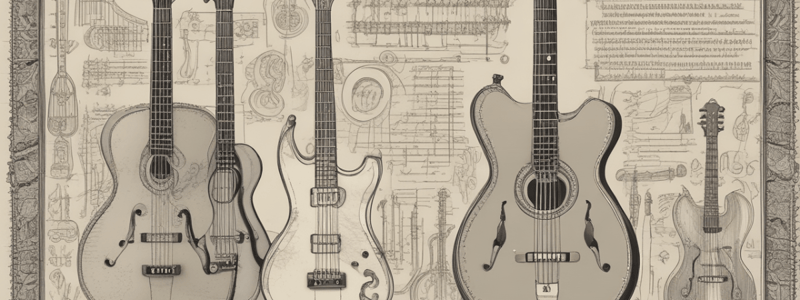Podcast
Questions and Answers
Existen muchas divisiones alternativas y subdivisiones de instrumentos. Generalmente, al estudiar
los instrumentos musicales es frecuente encontrarse con la clásica división de los instrumentos en
cuatro familias: viento, cuerda, percusión y los instrumentos eléctricos (creados por el hombre
hace aproximadamente 50 años)
Existen muchas divisiones alternativas y subdivisiones de instrumentos. Generalmente, al estudiar los instrumentos musicales es frecuente encontrarse con la clásica división de los instrumentos en cuatro familias: viento, cuerda, percusión y los instrumentos eléctricos (creados por el hombre hace aproximadamente 50 años)
piano = percusion tambor = percusion flauta = aire guitarra = cuerda
¿Cuál es el instrumento que produce sonido mediante la vibración de cuerdas?
¿Cuál es el instrumento que produce sonido mediante la vibración de cuerdas?
- Saxofón
- Guitarra (correct)
- Tambor
- Flauta
Los instrumentos idiofonos son aquellos instrumentos en los que el sonido procede de un cuerpo sólido y es generado por
vibración del instrumento mismo mediante percusión, frotación o pulsación.
Los instrumentos idiofonos son aquellos instrumentos en los que el sonido procede de un cuerpo sólido y es generado por vibración del instrumento mismo mediante percusión, frotación o pulsación.
- Verdadero ,como en el caso de las claves, xilófono, campana. (correct)
- Verdadero, como el timbal, tambor, conga.
- Falso, son solamente los que generan vibracion como claves,platillos, triangulo.
- Verdadero, como claves, platillos, guitarra,tambor
Durante el siglo XX se desarrolló un nuevo tipo de instrumento, los denominados............................................................................. En estos instrumentos, el sonido es generado por medios electrónicos, como en el sintetizador o el theremín.
Durante el siglo XX se desarrolló un nuevo tipo de instrumento, los denominados............................................................................. En estos instrumentos, el sonido es generado por medios electrónicos, como en el sintetizador o el theremín.
Flashcards are hidden until you start studying
Study Notes
Instrument Categories
- Aerophones: produce sound when air passes through them, examples include flutes, clarinets, and saxophones
- Chordophones: produce sound when strings vibrate, examples include guitars, violins, and pianos
- Membranophones: produce sound when a membrane vibrates, examples include drums and timpani
- Electrophones: produce sound electronically, examples include synthesizers and electric guitars
Common Instruments
- Wind Instruments:
- Flute
- Clarinet
- Saxophone
- String Instruments:
- Guitar
- Violin
- Piano
- Percussion Instruments:
- Drum
- Timpani
- Xylophone
Music Theory
Notation System
- Staff: a system of lines and spaces to represent music
- Note: a symbol representing a musical sound
- Duration: the length of a musical sound
- Value: the relative length of a note
Scales and Modes
- Scales: a sequence of sounds in a specific order of pitch
- Major Scale: a scale with a specific pattern of whole and half steps
- Minor Scale: a scale with a specific pattern of whole and half steps
- Modes: variations of scales that change the tonality
Chords and Progressions
- Chords: a combination of three or more notes played simultaneously
- Triad: a chord formed by a root, a third, and a fifth
- Progressions: a sequence of chords creating a harmonic line
Studying That Suits You
Use AI to generate personalized quizzes and flashcards to suit your learning preferences.




